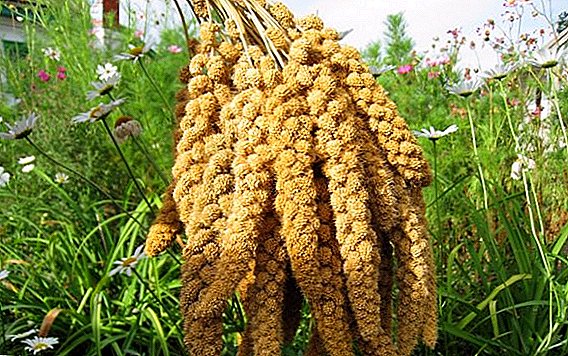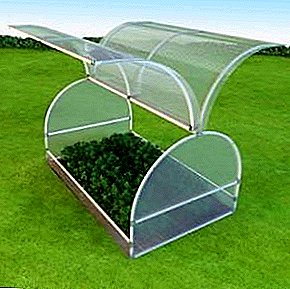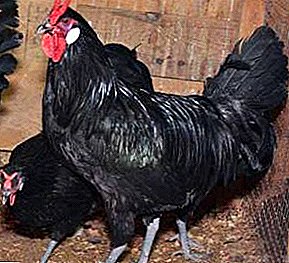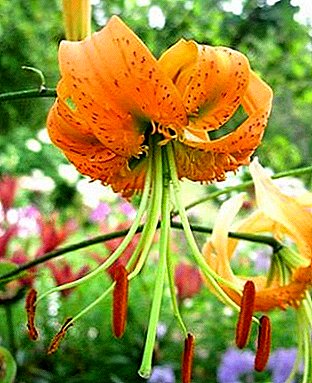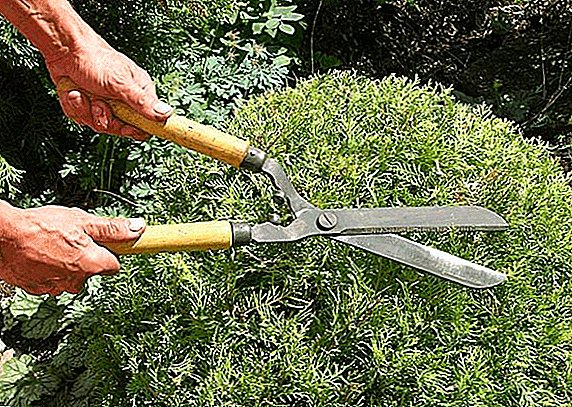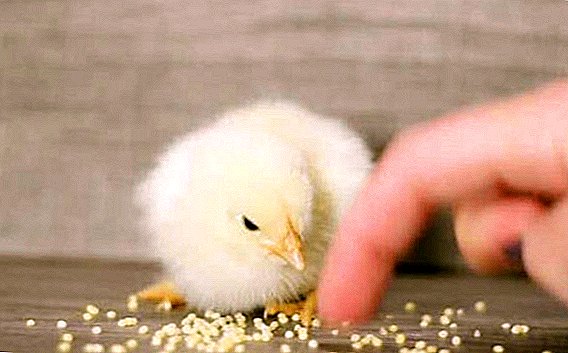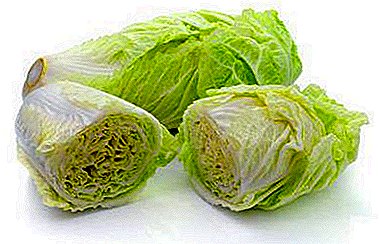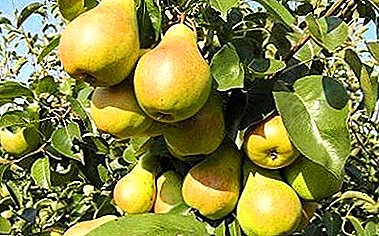
Skorospelku from Michurinsk without exaggeration be called record holder. In terms of fruit ripening speed, this variety has no equal and the first in the pear garden pleases the gardener with a fresh crop.
In addition, Skorospelka pear from Michurinsk has other virtues - endurance, amazing frost resistance and high yield, a full description of all characteristics and photos of the fruit later in the article.
What kind of pears refers?
 Skorospelka from Michurinsk is a summer variety with ultra early ripening of fruits of universal purpose.
Skorospelka from Michurinsk is a summer variety with ultra early ripening of fruits of universal purpose.
It is grown in gardens and in private plots for fresh consumption - its fruits are not stored for very long.
Also Skorpospelka from Michurinsk is perfect for canning - it makes wonderful juices, jams, jams and preserves.
Summer varieties also include: Fairy Tale, Northenian Krasnoshchekaya, Rogneda, Lel and Moscow Early.
Breeding history and breeding region
The early rifle from Michurinsk is the result of the breeding work of the VNIIGiSPR them. I.V. Michurin. Scientists S. P. Yakovlev and A. P. Gribanovsky bred this variety by complex crossing of an old-European variety of Western Europe "Citron de Carme"with a hybrid obtained from wild Ussuri pear and variety"Bere Liguel".
The state test of the new variety began in 1986. In 2002, he was included in the State Register. Early harvesting from Michurinsk is recommended for cultivation in Central Russia, Central Black Earth, and Middle Volga regions. The pear variety Skorospelka from Michurinsk has also proven itself in the gardens Northwest region. Gardeners get good Harvest crops from Michurinsk Moscow region.
In the Central region, children's, Memory of Zhegalov, Svetlyanka, Chizhovskaya and Hera are successfully grown.
Variety description Skorospelka from Michurinsk
Consider separately the appearance of the tree and fruit.
Tree
 This pear is a tall tree with a pyramidal crown. Long skeletal branches with flaky bark grow upward, forming a sharp angle with the trunk.
This pear is a tall tree with a pyramidal crown. Long skeletal branches with flaky bark grow upward, forming a sharp angle with the trunk.
The shoots are fairly straight and covered with a bark of a yellowish-brown color with a small amount of lentils.
Medium sized leaves have an ovoid shape with a pointed tip and a slightly serrate edge.
White flowers consist of overlapping petals. Flower sepals grow toward the pedicel.
Fruit
The magnitude of the fruit of the Horoscopelka from Michurinsk is below average, and the weight of each pear is from 70 to 100 g The shape of the fruit can be called perfect pear-shaped.
They are covered with greenish-yellow peel, which, when ripe, acquires a rich yellow color. Slight rustiness is observed on the skin of almost all fruits.
Tastes pears Skorospelka from Michurinsk canceled. The flesh is very juicy and tender with a sour-sweet taste, with a slightly loose structure and practically without granulations.
Chemical composition:
| Composition | amount |
|---|---|
| Sahara | not less than 8.2% |
| Acids | 0,78 % |
A photo








Specifications
Skorospelka from Michurinsk brings decent harvest of fruits almost every year. It begins to bear fruit in the fifth year of life, with age increasing yields. Reaching 10 years, trees of this variety are able to give up to 100 centners of fruit per hectare.
Pears are also high-yielding varieties: Bere Russkaya, Bere Bosk, Tonkovetka, Tatyana and Talgar beauty.
 The ripening Skorospelka from Michurinsk before all other varieties of pear - in the 20th of July, and sometimes 5-6 days earlier. In room conditions fruits are stored for about a week, and in the refrigerator - up to 2 weeks.
The ripening Skorospelka from Michurinsk before all other varieties of pear - in the 20th of July, and sometimes 5-6 days earlier. In room conditions fruits are stored for about a week, and in the refrigerator - up to 2 weeks.
Skorospelka from Michurinsk - samoplodny variety, its productivity rises significantly if the pollinator variety grows "In memory of Yakovlev".
On state tests, Skorospelka from Michurinsk showed itself as one of the most cold-resistant varieties. During artificial freezing, it adequately withstood even such a low temperature as -40 ° C.
The frost-resistant varieties include: Uralochka, Tikhiy Don, Chizhovskaya, Severyanka and Svetlyanka.
Cambia and bark did not freeze, the degree of damage to wood and kidneys did not exceed 1.5 points. Besides, the variety is distinguished by its endurance - it is not afraid of cold winds and sudden changes in temperature.
Planting and care
Pear Skorospelka from Michurinsk prefers to grow sunny and dry areaswhere groundwater lies at depth not less than 2.5 meters from the ground.
The best time to plant a pear is autumn (one month before the cold snap) and spring (immediately after the soil thaws). Many gardeners prefer autumn landingin which the seedlings have time to winter to acquire new roots.
 As a result, in spring the young pears will be ready for the beginning of the growing season.
As a result, in spring the young pears will be ready for the beginning of the growing season.
Pit deep up to 1 m and with a diameter of 80 cm to 1 m prepare 2-4 weeks before landing. If the soil on the site is sandy, it is desirable to place a layer of clay up to 20 cm thick at the bottom of the pit.
One-third of the pit for planting is filled with fertile and loose earth.
It is prepared from the following components: horse turf ground dug from the pit, about 3 buckets of manure (in no way fresh!) or rotted plant humus, 100 g of potash and 150 g of phosphate fertilizers.
If the soil is fertile, fertilizer is optional.
Before planting, a wooden peg about 140 cm high is driven into the hole. In the center of the hole they form a hillock and place a tree on it so that it is on the north side of the hammered peg. The roots of the seedling are spread around the sides and sprinkled with earth.
Wherein root neck should rise 3-5 cm above the surface. After watering the soil will settle and it will be at the right level. The soil around the tree tamped and shed water (2 to 3 buckets).
After planting, the seedling is tied to a peg and the soil Mulch with compost, peat or humus. In dry weather after two weeks, watering will need to be repeated.
Pear care includes regular weed removal, loosening and mulching of the stalk areathat help the absorption of nutrients and moisture retention.
 Late autumn before the onset of cold weather is necessary digging near-stem circles. The depth of digging next to the pear tree stand should be no more than 12 cm, and the rest of the area of the stem should be no more than 25 cm.
Late autumn before the onset of cold weather is necessary digging near-stem circles. The depth of digging next to the pear tree stand should be no more than 12 cm, and the rest of the area of the stem should be no more than 25 cm.
Watering pear requires rare, but plentiful - enough three times per season. (in spring, after flowering at the beginning of summer and in autumn during leaf fall). The optimal amount of water for a single adult tree is at least 3 buckets per square meter of the trunk circle.
In the first year after planting, feeding of young pears is not required, because they are planted in fertile soil already fertilized. As they grow and start fruiting, trees begin to need annual fertilizer.
There are many options for dressings. Each gardener selects his fertilizer system based on the age and state of health of the pear, the composition of the soil on the site and the climatic conditions.
In the spring the pear needs nitrogen fertilizers.The most common of them are urea (25 g per 1 sq. m of the tree surface) and ammonium nitrate (30 g per 1 sq. m).
It is recommended to carry out two dressings: before and after the bud opening.
In the fall, trees are fertilized with a mineral complex., which can be bought in a specialized garden center or cook yourself.One of the options for such dressing: dilute 1 table spoon of potassium chloride and 2 tablespoons of superphosphate in 10 liters of water - this is the dose per 1 sq. M. Every two or three years organic material is introduced under the pear, the best option of which is compost or manure (approximately 2 kg on 1 sq m).
Fruits of the Pear Skorospelka from Michurinsk prone to shallowing at a bountiful harvest. The size of its fruit helps rationing of fruiting using an annual trim.
 In the autumn they carry out sanitary pruning. with the removal of dry, diseased and damaged shoots. In the spring of young pears form a crown, pruning too long shoots.
In the autumn they carry out sanitary pruning. with the removal of dry, diseased and damaged shoots. In the spring of young pears form a crown, pruning too long shoots.
Adult trees need spring support or rejuvenating pruning. Removed branches growing down into the crown or to the side.
Also cut tops, weak shoots and too long branches. As a result of such pruning, fruiting is not only normalized, but crown ventilation is also improved.
Diseases and pests
Pear Skorospelka from Michurinsk practically not sick //selo.guru/ptitsa/bolezni-p/gribkovye/parsha.htmlbut under adverse conditions affected by moniliasis in the form of fruit rot. The main source of infection is rotten carrion overwintered in the garden. The spores formed on it are carried by the wind, the spray of rain and insects.
Resistance to scab is distinguished by the following varieties: Cathedral, Krasulia, Lada, Elegant Efimova and Otradnenskaya.
Moniliasis primarily affects fruits with damaged skin. The disease begins with the formation of a brown spot, which, gradually expanding, covers the entire fetus. Without taking proper measures, the rot moves to the neighboring fruits.
To avoid moniliosis, you need to remove sick pears from the trees in time and destroy the carrion. Too dense crown is important to thin out in time. As a preventive measure before the swelling of the buds trees sprayed with urea solution.
Begin to protect pear trees from pests should fall. Most insects overwinter in foliage and soil, therefore cleaning leaves and digging the wheel circle help to exterminate a significant part of them. In addition, after the leaves are falling on the branches, cocoons of insects wintering in the trees are clearly visible. They are collected and burned.
 Much of the ticks, scarab and other pests that hibernate on the pear can be destroyed, taking off the old bark from the trunk and whitening the shtamb.
Much of the ticks, scarab and other pests that hibernate on the pear can be destroyed, taking off the old bark from the trunk and whitening the shtamb.
Any fungicide can be added to the whitewash lime. This will increase the effectiveness of the procedure. With a large number of pests in the summer several tree treatments with chemicals.
When choosing a sapling for your pear orchard, pay attention to the variety of pear Skorospelka from Michurinsk - this pear will never let you down and before all will provide a rich harvest of fruits with excellent taste.


